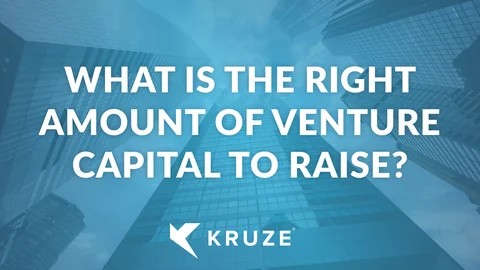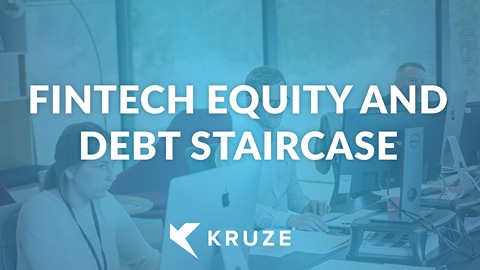
In a recent interview with Fortune, Scott Kupor, managing partner at Andreessen Horowitz, discussed how to raise the right amount of venture capital. Picking the amount of funding to raise is a common question our clients ask us, as we help them prepare for a venture round. So we thought that we’d use Scott’s wisdom as a jumping off point to discuss how much VC to raise.
How large should a venture round be?
Andreessen’s Kupor says,
People don’t always think critically enough about what is the right amount of money to raise. What we try to encourage entrepreneurs to think about is: Think about what the story is around the milestones you’re going to want to tell at the next fundraise. When you’re raising the Series A round, think about what you’re going to tell your investors at the Series B round. And then you can back into your number.
Basically, in order to know how large of a round to raise, you need to 1) know what milestones you’ll have to hit to be worth more and be successful in the NEXT round and 2) have a strong idea of how much cash you’ll need to achieve those value creation milestones 3) have capital expectations inline with the industry and opportunity.
How valuation creation milestones impact the size of a VC round
How do you know what the milestones are for your business? One way is to look to businesses with similar business models. This is easy enough in deep spaces like enterprise SaaS, eCommerce and biotech. Find the companies that are similar to your startup - and that are successful at making it to the next stage - and understand the metrics they used to drive their fund raises. For example, for SaaS startups, investors expect a certain level of revenue growth over time, and are looking for that trend to continue after the fund raise. For biotech companies, investors expect particular scientific milestones, and eventually, clinical trial data.
How do you determine how much cash you’ll need to hit those milestones?
This is where your startup will need to develop a financial model.
For very early stage companies, this can be pretty “back of the envelope.” Typically, the majority of your expenses will be headcount, with some legal and product development costs, potentially some rent - nothing too crazy. You can model out your salaries + benefits, add in a few new heads, get your rent, reserve some $ for product development and don’t forget legal expenses. Then, estimate the number of months you need to reach the value creation milestones. Make sure you have enough employees to get you there - if you have a lot of product development work to do, you need to have enough engineers, designers, researchers, etc.
For later stage companies, the process can become more complicated. In this case, I would suggest consulting your investors to make sure you know what the milestones are first - then build your budgets and projections to get you there. Work closely with your team to design the projections. For example, if believe that you need a certain amount of revenue growth before the next round, make sure your sales and marketing leaders know what they’ll need to achieve, and can articulate back to you what it will take to get there. Don’t be afraid to tell them that they need to be economical, but do make sure to include them in the process so that you get their input and buy-in.
Regardless of the stage, it is a good idea to pencil in a few extra months of burn. Adding 25% to the amount that you think you need is a safe bet, assuming you can raise it.
Fit the capital raise to the opportunity
Don’t make the mistake of trying to raise millions of dollars for a company that will only generate a small amount of revenue or profit. VCs, and you, should want to size the amount of capital needed to the market opportunity. Big markets can support bigger players, meaning you can raise more capital to get there. You also need to compare yourself to other startups in the space. While it is totally possible to raise 3 or 4 times more than the other competitors, planning to be the most capital-intensive company can put potential investors on alert. Make sure you know what the competition has raised, and if you are doing something dramatically different, have a compelling reason.
How long should a venture capital round last?
Typically, a Series A and beyond VC raise should last at least 18 months. Your existing investors (and new investors) will have their own opinions, and may want to discuss how you’ll stretch to get to 24 months with the capital. (Side note: Venture Debt, which we consult on, is a way to get lower cost startup capital). Today, we are seeing our hottest startup clients raising their B’s and C’s faster than expected, well before 18 months and well before they are running out of cash. This is a symptom of the hot venture capital market, but also a testament to our clients, who are clearly hitting their value creation milestones quickly due to phenomenal execution. If your growth (or other metrics) are strong enough, you can raise before you are low on capital and sooner than 18 months.
Seed investments have been very different recently, with many companies raising multiple seed rounds. The rough rubric of 18 months of runway are becoming increasingly less meaningful for today’s seed rounds, making it more difficult to know how long your seed round should last. Regardless, make sure that the amount you are raising in a seed round will get you somewhere more valuable. Even if your seed investors are telling you that they are offering you an open checkbook, you should strive to have proven or learned or built something more valuable by the time that you have to ask for additional seed funding!
Putting together a projection model is an important piece of your fund raise. Our clients have raised over half a billion dollars in venture funding in the past 12 months, and we have experience helping companies get their projections in order. If you need help with a financial model, reach out to us today!
Another perspective on the correct amount of capital to raise
From Scott Orn
How should you answer when a venture capitalist asks you how much capital you want to raise? This is a question that many people can overthink, so let’s look at how you should determine the amount to request, so that you can achieve the best possible outcome in your quest for venture capital funding.
Honesty rules
The first thing to do that is crucial is to tell them the truth. At the start of the relationship with your VC, honesty and transparency is the best policy. Venture capitalists sit in meetings with startups all day and the cat and mouse game of ‘are you under asking or over asking’ can get really old.
Most of the time when a VC is interested in a company they are ready to write the check. They just need to know what the ask is. That is why they are asking the question; it isn’t a trick.
Asking the appropriate amount
A really important thing that you need to think about before you go into this meeting is what is the right amount of venture capital to raise? You have to consider if your asking amount of funding is relevant for the stage that this VC firm plays at. If you go to a seed fund and ask for 10 or 20 million dollars they are most likely going to look at you and wonder why you are wasting their time. The same goes for if you are asking a series A fund for one million dollars.
You have to make sure you correlate your asking amount with the stage of the VC firm that you are pitching.
Do the Math
Most venture capitalists will assume that they will be buying around 20% to 25% of a startup when they invest. Make sure you have done the math:
- Whatever you are asking for in terms of capital, multiply that by five and that will give a 20% ownership.
- For example, if you are asking for $2 million you are implicitly asking for a $10 million valuation. If you are asking for $20 million you are roughly asking for an $80-$100 million valuation. That would be 25% ownership.
Venture capitalists will do this math in their heads in a millisecond, so ensure that you have done the correct math before you go into that meeting.
Attitude analysis
When a VC asks you for the amount of capital you want to raise they are also assessing your attitude from your answer.
More often than not a VC will also be testing to see how ambitious you are. Most venture capitalists will make their money on a couple of the investments in the fund that return 10, 20 or 50 times the amount they put in. Therefore, they will typically want to invest in the most ambitious founders. This question that will show them if you are asking for too little capital or if the vision is too small.
Two different approaches
When you go into this meeting with a venture capitalist there are two different ways to approach them.
- Take-over-the-world ambition. If you have a big, ambitious attitude then tell your VC that and ask for more money.
- The low burn rate game. Asking for a more conservative amount until you have success in your grasp before accelerating with more funding is the other approach to take.
Despite some VCs looking for ambition, there is such a thing as too much and so both styles can work very well. Here at Kruze Consulting we have seen many great exits, outcomes, and some very happy entrepreneurs when they keep the burn rate low. We have also seen a number of companies that raise a large amount of capital and have been very successful.
The thing to focus on is conviction. By knowing what kind of company you are and showing them that, you create transparency.
Industry knowledge
The other thing VCs will be looking for when they ask you this question is how well you know your industry and its capital requirements. This is possibly the main reason for asking you for your capital amount.
The odds are, for any venture capital firm that has been around for a while, they have probably funded multiple companies in your space. Therefore, they know via experience how much capital it really takes, especially for capital intensive companies (companies that require a lot of funding for machines, equipment and plants).
By asking this question they want to make sure that you know what it’s going to look like and that you are both aligned in your thinking.
Finding the right match
This brings us back to the first point about honesty. It is very important to make sure that you are going to be working with a venture capital fund that suits your goals, behaviors and values and that you suit theirs. If they are a conservative firm they don’t want a startup that will blow through their cash in nine months. If they are a bold and ambitious VC they aren’t going to expect you to make the money last for three or four years.
Engaging with venture capitalists is a lot like dating and, unfortunately, it has become a lot like speed dating over the last year. However, that is slowing down. The key things to remember when your VC asks you about your funding expectations are:
- Honesty. Being open, honest ad transparent will gain your VC’s trust.
- Appropriate amount. Make sure you have thought properly about the amount you are asking for and the firm you are asking for it from.
- Do your homework. Make sure you are well informed about your industry so you can ensure your VC you have realistic understanding and expectations and remember to do your math before the meeting!
If you have any other questions about venture capital fundraising, startup accounting, or startup bookkeeping please contact us.
You can also follow our youtube channel and keep an eye on our blog for information on accounting, finance, HR and tax for startups!















